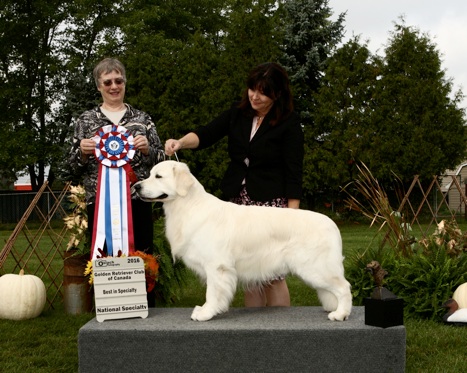I am a member of the Golden Retriever Club of America, Sandlapper GRC and the Golden Retriever Club in England. My dogs are imported from Europe, but make no mistake. They are GOLDEN RETRIEVERS. Nails on a chalkboard if you say “English Cream” to me. That’s a marketing ploy to make cream coated goldens appear “rare” or “unusual” so puppy mills can charge you an arm and a leg for one of their puppies. They aren’t rare or unusual. All Goldens are Golden Retrievers! Mine are the British style but they are still Goldens.
Golden retrievers are prone to several hereditary conditions. These conditions include hip dysplasia, elbow dysplasia and eye issues listed below. There are other conditions but these are the ones we test for. Dogs who may be bred are screened prior to mating, and although it is never possible to guarantee that clear parents will produce all clear off-spring the likelihood is much increased.
OFA EYE SCHEME
At present Goldens are examined for 3 eye conditions:
Hereditary Cataract (HC)
Progressive Retinal Atrophy (PRA)
Multifocal Retinal Dysplasia (MRD)
Our dogs are given an eye exam once per year with an ophthalmologist, to screen for inheritable eye issues.
British Veterinary Association/Kennel Club Hip Scheme
Hip dysplasia (HD) is an abnormal development of the hip joint, influenced by hereditary factors, nutrition and exercise.The hip is a ball and socket joint and in HD the socket may be shallow so the head of the femur fits loosely which in turn leads to wear and tear and arthritic changes. The disease is characterized by bunny jumping when running, stiffness after exercise and difficulty in getting up.
Under the BVA/KC scheme the dog’s hips are x-rayed when the dog reaches a minimum of 12 months of age. The plates are then submitted to a specialist panel at the BVA who assess 9 features of each hip, giving each feature a score. BVA scores total between 0 and 108 on hips. BVA scores are like golf…the lower the score, the better. If our dogs have a cumulative score of 21 or less, they are put into our program. You may only do a BVA test once in the life of a dog. We use the BVA for hips and choose this method because the information you glean about hips is so much more detailed than the OFA. While we are adding OFA to our list of clearances for our dogs, we find the BVA to offer a wealth of information that frankly the OFA just doesn’t. That’s why we use this health system.
British VeterinaryAssociation/Kennel Club
Elbow Scheme
Elbow dysplasia is a condition that can manifest in a variety of developmental disorders of the elbow leading to osteoarthritis of the elbow joint. The disease has a genetic component which is why breeders look at this. The scores for each elbow range from 0 (clear) to 3 (badly affected). Typically a dog with an elbow score of 1 or 0 are used in breeding programs.
OFA vs BVA
The United States uses the Orthopedic Foundation for Animals (OFA) for heart, hip and elbow testing to make sure a dog is healthy and free of hip and elbow dysplasia and heart defects. Breeders from other countries can also do testing using the OFA. The BVA does hip and elbow testing in the United Kingdom but breeders in foreign countries may use the BVA for testing as well. We use the BVA for hip testing for our dogs because we believe their assessment of hips and elbows is much more thorough and provides a fair assessment. Because of a change in the GRCA Code Of Ethics, we are adding OFA hip and elbow clearances and all of our up and coming dogs will have OFA clearances.
OFA Heart Clearance
In addition to testing eyes, hips, and elbows, we also test our dogs hearts to make sure they are free of any kind of hereditary heart defect that could be passed on to their puppies. The OFA is the body that does these heart tests in the US.
Ichthyosis
Ichthyosis is a hereditary skin condition found in many breeds. Some people have equated it to dandruff but in varying degrees. Some dogs have a horrible case of it with scabs and sores and they live with this their entires lives while other dogs may be affected with it and never have a flake on them. Recently a test has been created to test to see if a dog is clear, a carrier or affected. Some breeders don’t test for this because the test is new and they feel there are more important health issues to be concerned with. I feel if I can help put a stop to the spread of Ichthyosis, it’s my responsibility to do so. That’s why I test all of my dogs and follow the proper protocols to prevent (as much as one can) spreading Ichthyosis into my puppies. There is a much more detailed explanation of Ichthyosis at www.optigen.com where you can learn more about this condition and tests available.
PROGRESSIVE RETINAL ATROPHY (PRA1 AND PRA2)
PRA is a hereditary eye condition that can cause blindness in a dog. We health screen all of our dogs for PRA1/PRA2/PRCD. The PRA tests are tests given to Goldens once and if we do not know if the parents of our dogs are free from PRA-1, PRA-2 or PRCD (Goldens can’t have it if their parents are free of it), we will test our dogs for this. My dogs are tested for all three to be safe.
In recent years there have been other tests made available specifically for Golden Retrievers including tests for Neuronal Ceroid Lipofuscinosis 5 (NCL5), Degenerative Myelopathy (DM), Muscular Dystrophy, Dystrophic Epidermolysis Bullosa, and Osteogenesis Imperfecta. We use Embark Vet and test for over 200 diseases in our dogs to help us make good health decisions in our breeding program.

